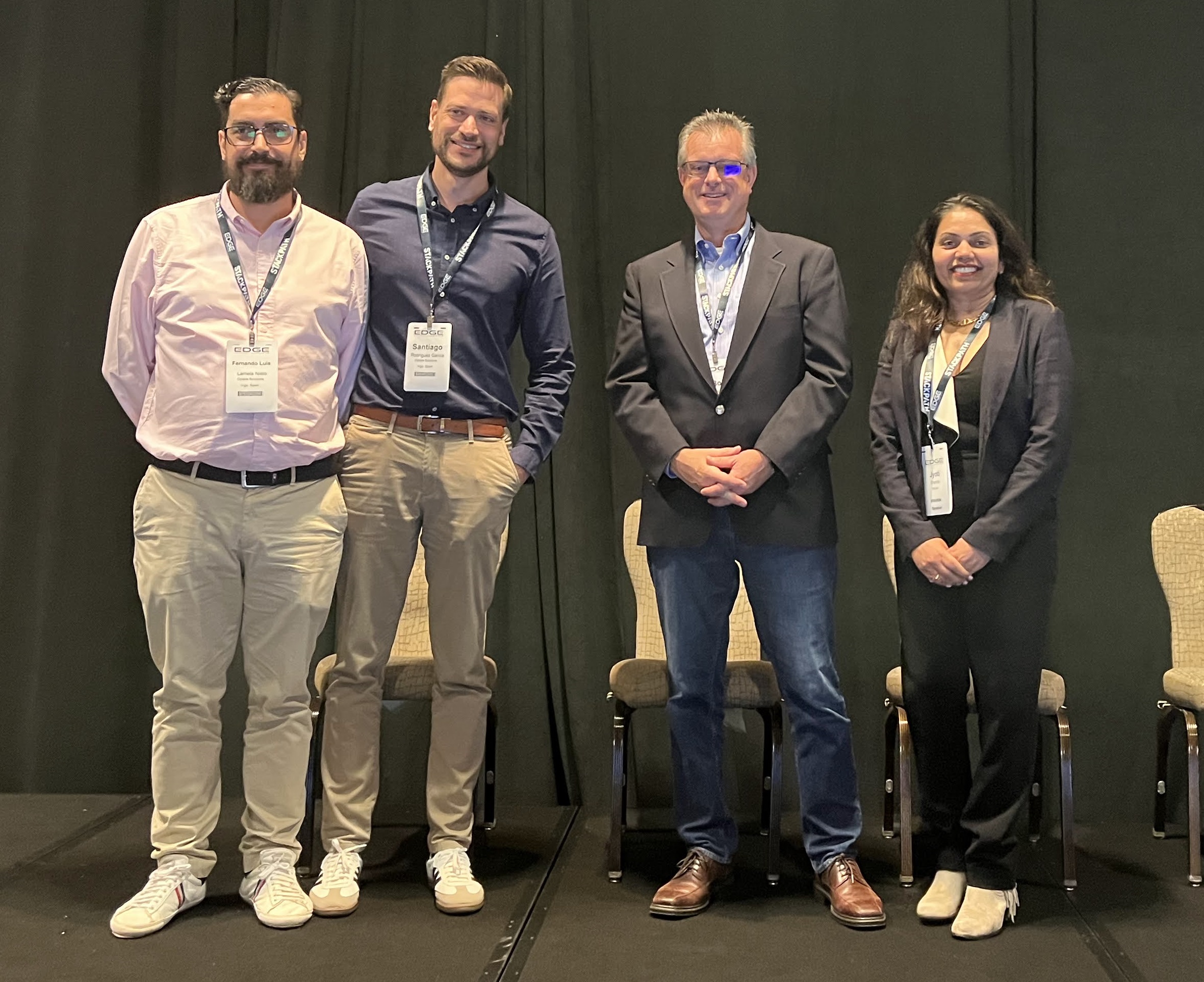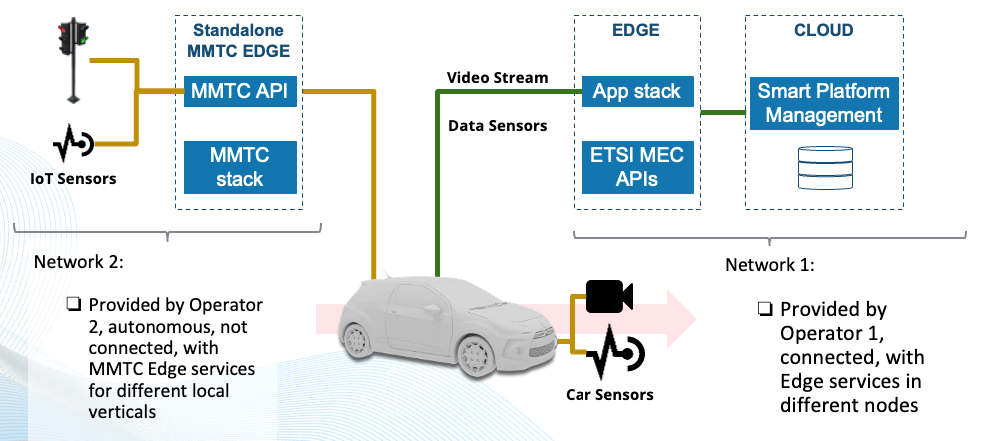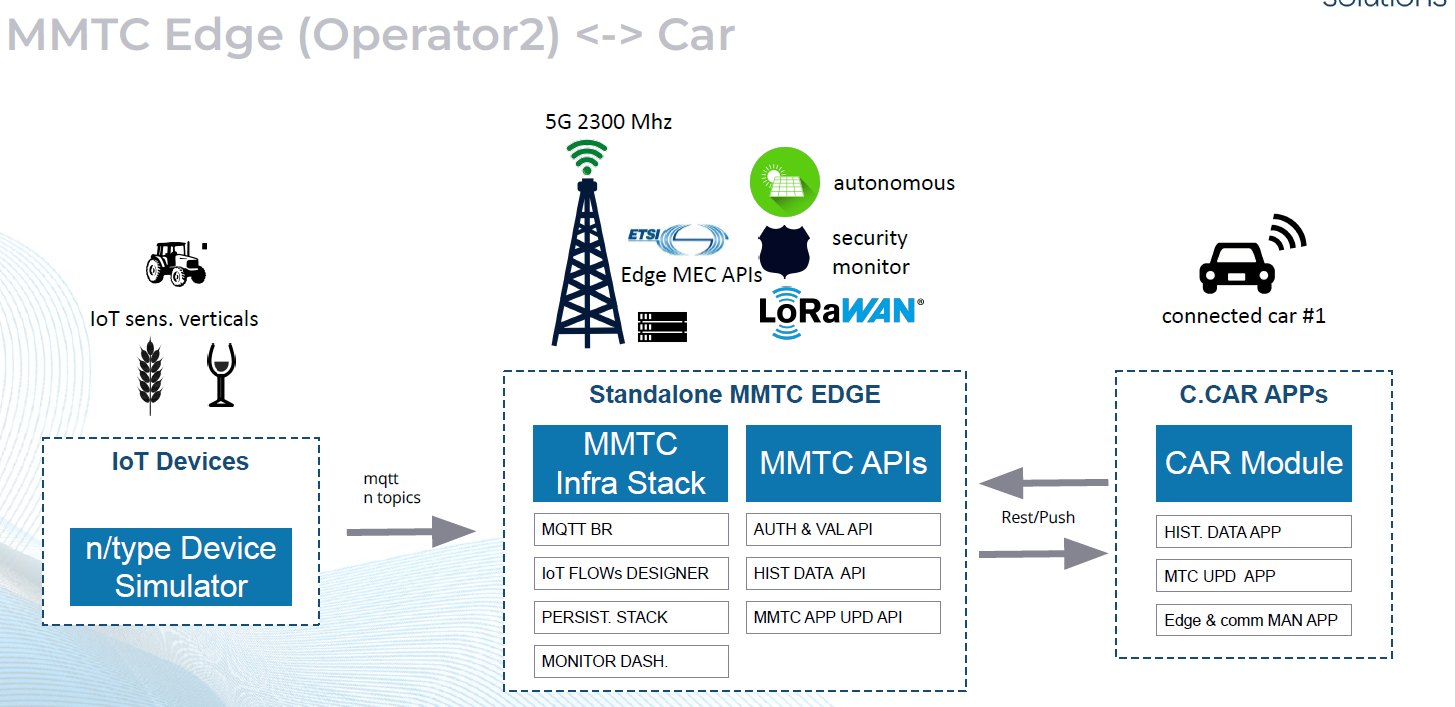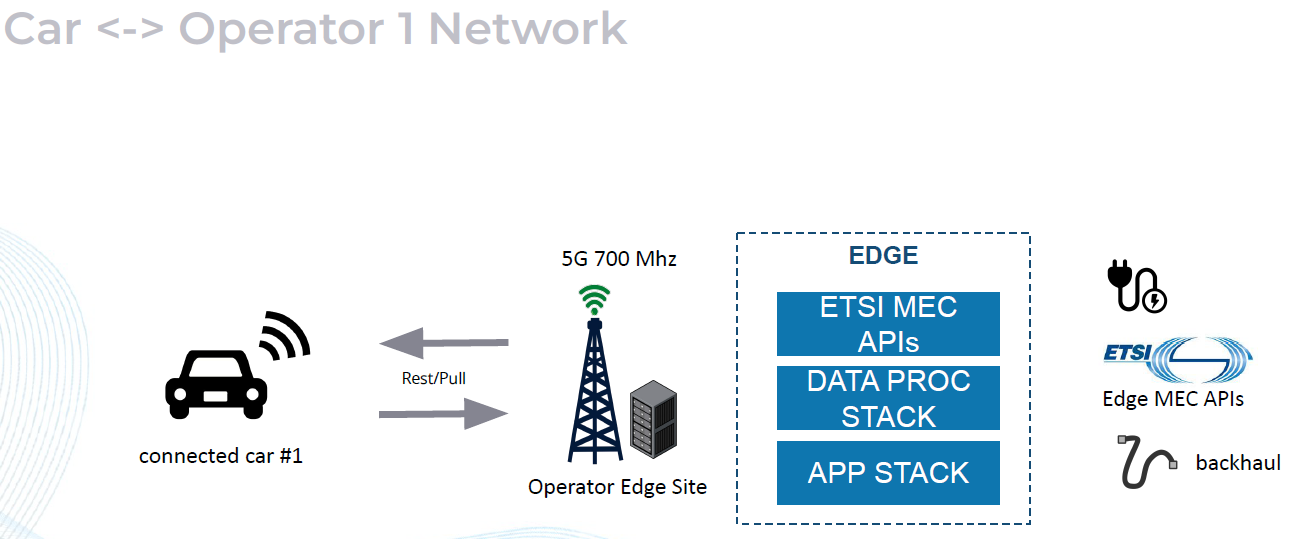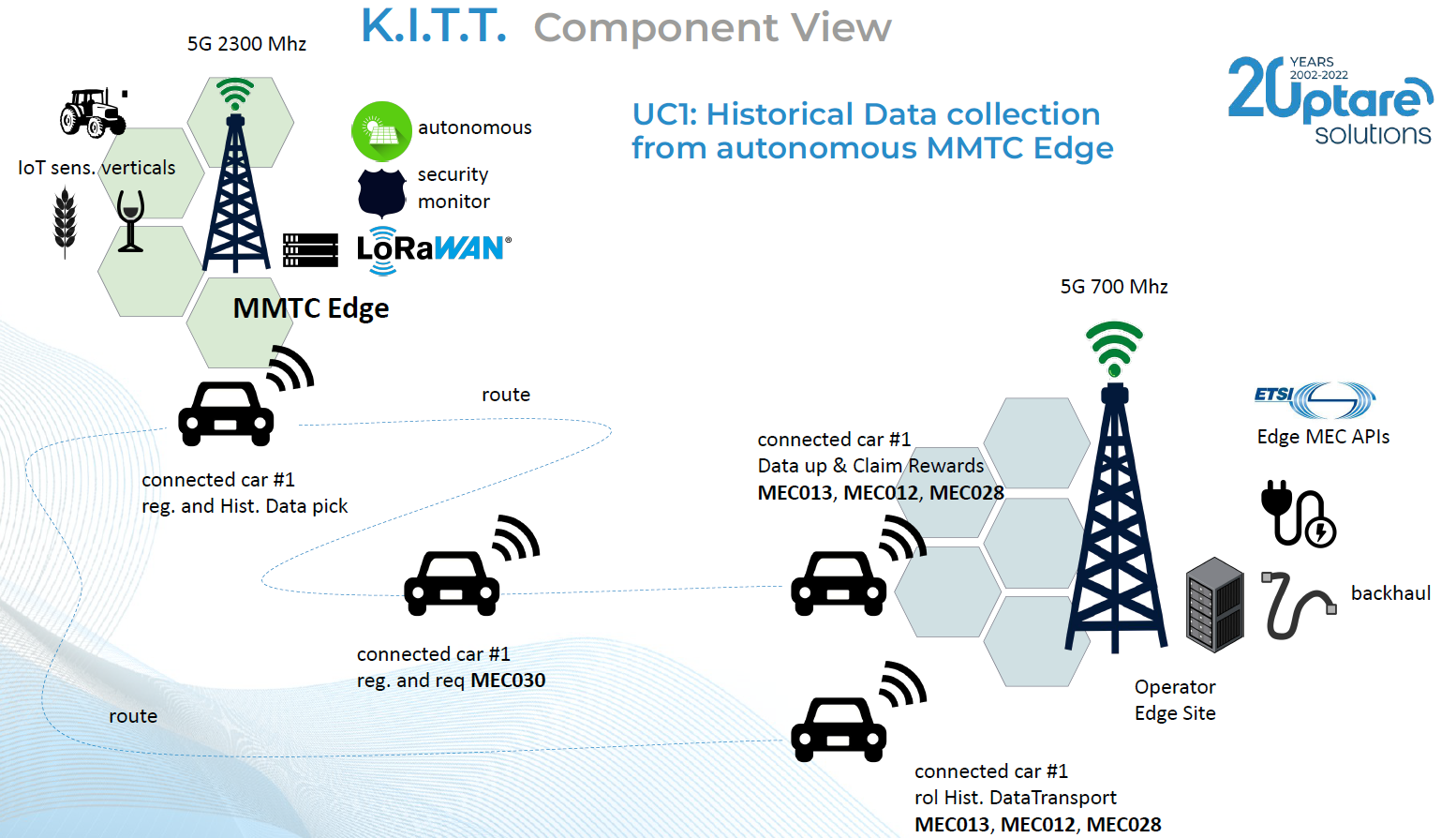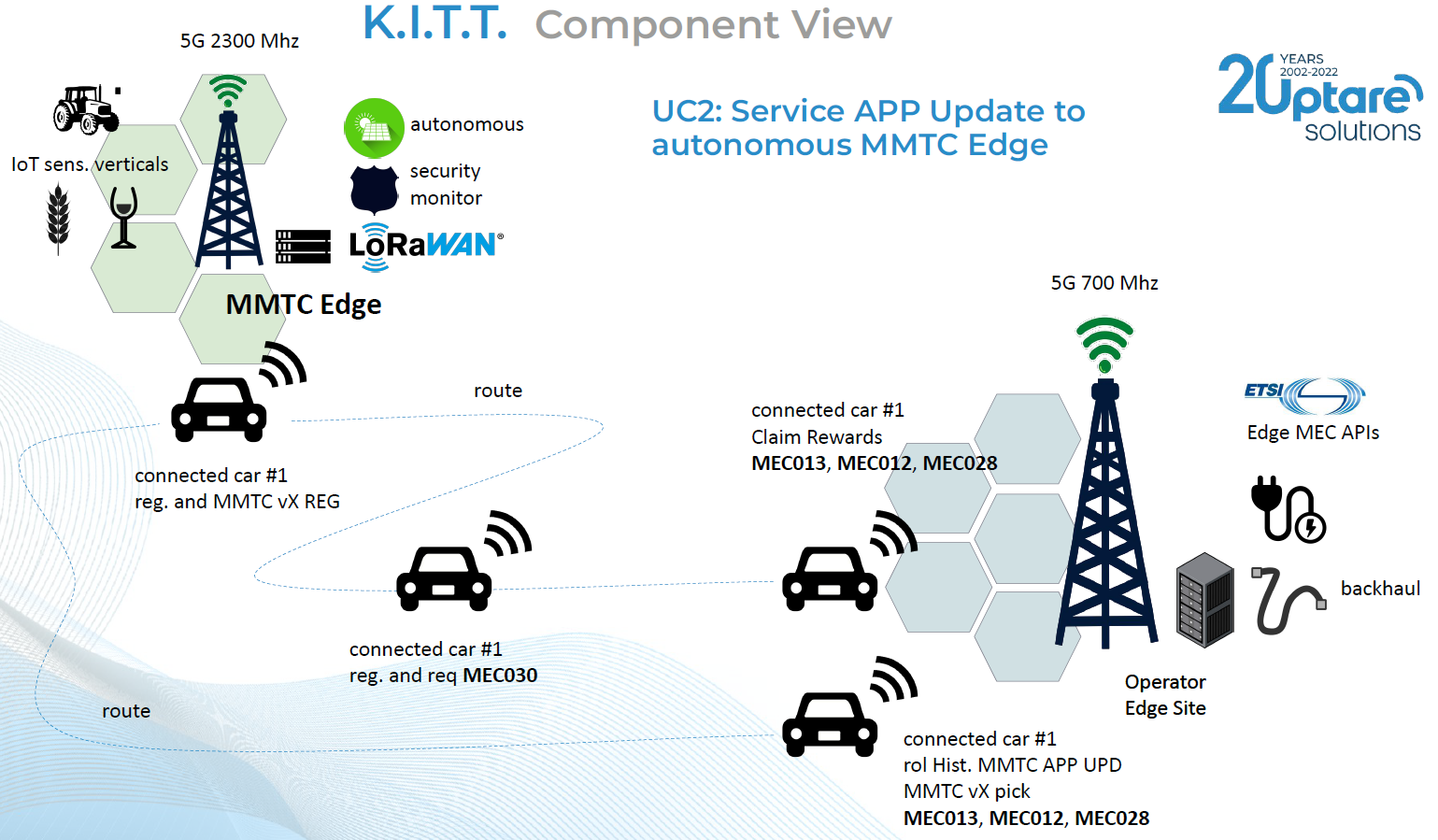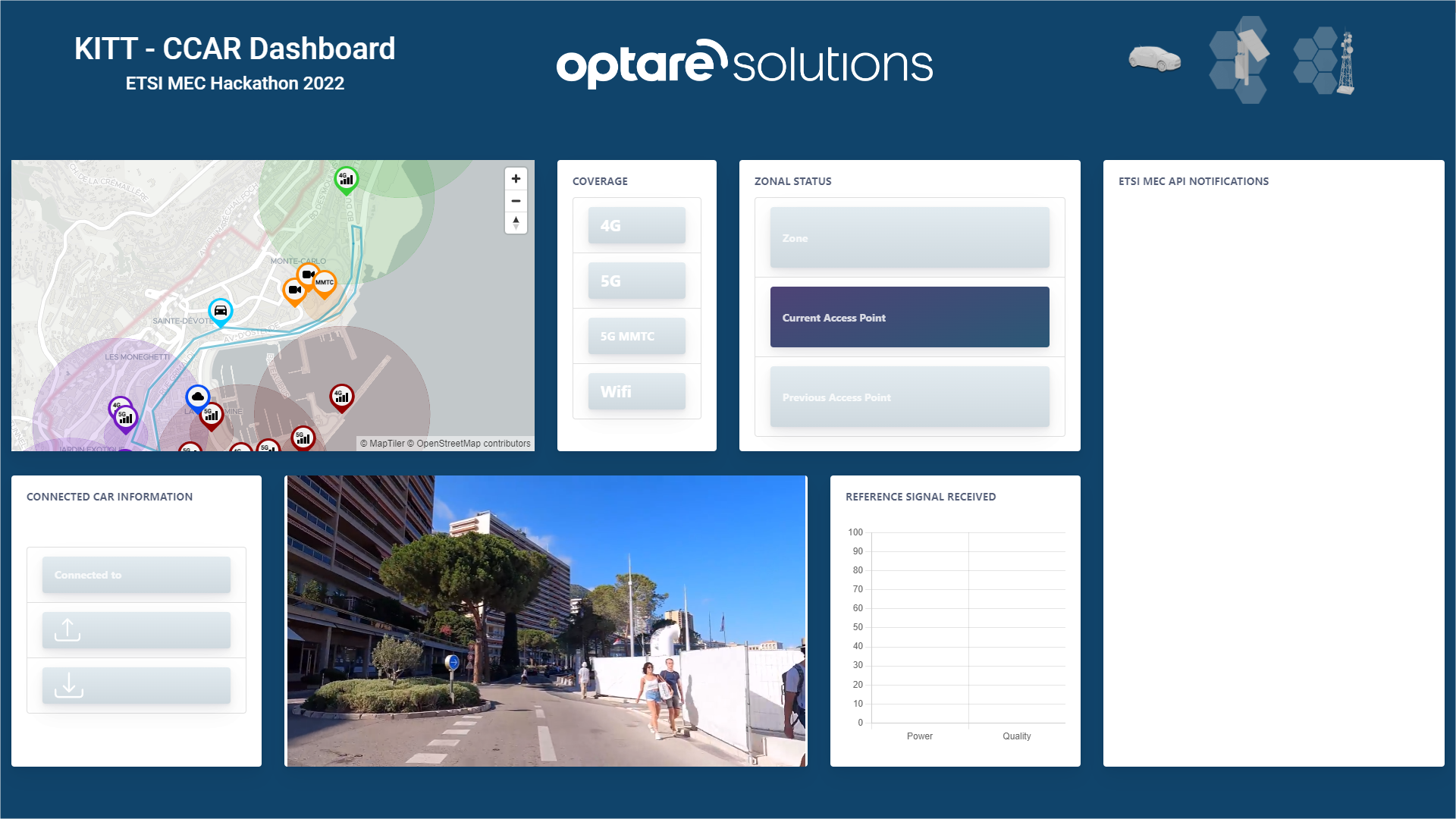Hack2022 3rd Prize: Difference between revisions
No edit summary |
No edit summary |
||
| (19 intermediate revisions by the same user not shown) | |||
| Line 1: | Line 1: | ||
<p class="left" style="font-size:26px;"> ←''[[ETSI_-_LF_MEC_Hackathon_2022|MEC Hackathon 2022]]''<p> | |||
<br> | |||
{{DISPLAYTITLE:<span style="position: absolute; clip: rect(1px 1px 1px 1px); clip: rect(1px, 1px, 1px, 1px);">{{FULLPAGENAME}}</span>}} | {{DISPLAYTITLE:<span style="position: absolute; clip: rect(1px 1px 1px 1px); clip: rect(1px, 1px, 1px, 1px);">{{FULLPAGENAME}}</span>}} | ||
<p class="center" style="font-size:34px;"><b>3<sup>rd</sup> Prize Award & Automotive | <p class="center" style="font-size:34px;"><b>3<sup>rd</sup> Prize Award & Automotive Special Prize</b><p> | ||
<p class="center" style="font-size:34px;"><b> K.I.T.T Knowledge in the traffic | <p class="center" style="font-size:34px;"><b> K.I.T.T Knowledge in the traffic | ||
| Line 12: | Line 14: | ||
<div class="flex-row row"> | <div class="flex-row row"> | ||
<div class="col-xs- | <div class="col-xs-5 "> | ||
<div class="panel panel-default"> | <div class="panel panel-default"> | ||
<div class="panel-body"> | <div class="panel-body"> | ||
Team | Team from '''Optare Solutions''' | ||
* Xose Ramon Sousa Vazquez | * Xose Ramon Sousa Vazquez | ||
* Santiago Rodriguez Garcia | * Santiago Rodriguez Garcia | ||
| Line 26: | Line 28: | ||
</div><!-- End of col 1--> | </div><!-- End of col 1--> | ||
<div class="col-xs- | <div class="col-xs-7"> | ||
<div class="panel panel-default"> | <div class="panel panel-default"> | ||
| Line 32: | Line 34: | ||
[[File:Edge Hackathon 2022 - Automotive Special Prize.jpg|600px|center|top|class=img-responsive]] | [[File:Edge Hackathon 2022 - Automotive Special Prize.jpg|600px|center|top|class=img-responsive]] | ||
</div> | </div> | ||
<div class="panel-footer">Santiago Rodriguez | <div class="panel-footer">From left to right, Fernando Lamela and Santiago Rodriguez with Jury members Bob Gazda (InterDigital) and Jyoti Sharma (5GAA Board/Verizon)</div> | ||
<!-- <div class="panel-footer">Footer text 1</div> --> | <!-- <div class="panel-footer">Footer text 1</div> --> | ||
</div><!-- End of pan --> | </div><!-- End of pan --> | ||
| Line 41: | Line 43: | ||
= Introduction = | = Introduction = | ||
<p> | <p> | ||
* A connected vehicle (car) that with the support of 5G, MEC and artificial intelligence technologies is able to capture information from the surrounding environment and feed a smart | * A connected vehicle (car) that with the support of 5G, MEC and artificial intelligence technologies is able to capture information from the surrounding environment and feed a smart platform with this information which can predict and adopt several actions for the good of people. | ||
[[File:hack2022-optare- | [[File:hack2022-optare-architecture1v2.png|800px|center|top|class=img-responsive]] | ||
<br> | <br> | ||
* The information retrieved by the car and sent to the platform is collected by three different ways: | * The information retrieved by the car and sent to the platform is collected by three different ways: | ||
** '''camera:''' the car is equipped with a camera that sends a video stream to the edge over which is executed an AI inference algorithm to detect several patterns and generate information packages relevant to the smart platform. | |||
** '''sensors:''' the car is equipped with several sensors (temperature, humidity, …) that can create heat maps with this information to the smart platform. | |||
** '''the smart environment itself'''. In regions/areas where the information sources are isolated (low power, low signal quality, bad coverage due maintenance, weather conditions, etc), the car can act like a link between the information source and the smart environment platform, uploading this information in the next available coverage area crossed by the car in its route. | |||
* Every information contribution to the smart environment could be rewarded with points that can be exchanged with tax discounts, for example, guaranteeing the participation of the people establishing missions with a different degree of value. | |||
* Every connected car can register on the smart environment platform and provide several information about the environment and people. | |||
* | |||
</p> | </p> | ||
| Line 64: | Line 65: | ||
<br><br> | <br><br> | ||
= | = Use Cases = | ||
== UC1: Historical Data collection from autonomous MMTC Edge == | |||
[[File:hack2022-optare-component-UC1.png|800px|center|top|class=img-responsive]] | [[File:hack2022-optare-component-UC1.png|800px|center|top|class=img-responsive]] | ||
<br> | |||
* Context: two different networks, | |||
** Provided by Operator 1, connected, with Edge services in different nodes. | |||
** Provided by Operator 2, autonomous, with MMTC Edge services for different local verticals and with LoraWan connectivity for security monitoring. | |||
'''UC.1:''' a connected car scenario where it can act, once registered, as a carrier of the historical data generated by all the IoT devices connected to the MMTC Edge during an interval of time, in order to be stored and processed by services and the resources provided by the Operator 1 Edge. | |||
* Considerations: | |||
** MMTC Edge need to be efficient and guaranty IoT Flows based services to local verticals, with limited resources and delivers local 5G connectivity to IoT Devices | |||
** Edge can have more resources, in addition to 5G connectivity, with backhaul, and can serve applications and services where it can balance between local and cloud. | |||
<br><br> | |||
== UC2: Service APP Update to autonomous MMTC Edge == | |||
<br> | |||
[[File:hack2022-optare-component-UC2.png|800px|center|top|class=img-responsive]] | [[File:hack2022-optare-component-UC2.png|800px|center|top|class=img-responsive]] | ||
* In the context of two different networks, | |||
** Provided by Operator 1, connected, with Edge services in different nodes. | |||
** Provided by Operator 2, autonomous, with MMTC Edge services for different local verticals and with LoraWan connectivity for security monitoring. | |||
'''UC.2:''' a connected car scenario where it can act, once registered, as a carrier of new versions, if exist, of MMTC IoT Security Flows, as a part of the ‘firmware’ of the node, that can be updated once security checks were passed. | |||
* Considerations: | |||
** MMTC Edge provides different functionalities related with the management of IoT devices and data produced, delivering an optimized environment for some verticals in locations with reduced access to broadband communications. | |||
** MMTC Edge provides secure graphical access for customers to modify their own IoT Flows, but no to update or modify security flows (firmware), that only can be updated by an operator or by a connected car (with this UC) once is registered and security checks are made. | |||
<br><br> | <br><br> | ||
= | = Software resources = | ||
• '''Project repository''' | |||
https://github.com/flamela/kitt-etsi-hackathon22 | |||
[[File:hack2022-optare-car_dashboard.png|600px|center|class=img-responsive]] | |||
= Hackathon Alignment = | |||
<p> This project has fullfilled the hackathon criteria required by the jury </p> | |||
{| class="wikitable" | {| class="wikitable" | ||
|+ | |+ | ||
|- | |- | ||
|''' | |'''Innovation''' | ||
| | |[[File:hack2022-optare-outcome2.png|60px|center|class=img-responsive]] | ||
|Digital divide of 5g end edge in some areas because its complexity and the | |||
cost to bring. The mobile backhaul via vehicular net could help on that | |||
proposing a network and computation for agriculture and remote industries | |||
|- | |- | ||
|''' | |'''Use-Case / Solution Credibility''' | ||
| | ||[[File:hack2022-optare-outcome2.png|60px|center|class=img-responsive]] | ||
|Create a platform with capability for sending and receive data using the | |||
different edge covered areas and using cheap and autonomous equipment | |||
for a quick deployment. Integrated demo is created for hackathon | |||
|- | |- | ||
|''' | |'''Use of ETSI MEC Services''' | ||
| | ||[[File:hack2022-optare-outcome2.png|60px|center|class=img-responsive]] | ||
|MEC013 for location information, MEC012 for radio network information, | |||
MEC021 for mobility and depending on the availability of more than one | |||
sandbox mep, MEC030 related with V2X and the automotive blueprint | |||
MEC011 for application registration, mec service discovery | |||
|- | |- | ||
|''' | |'''Use of LF Edge Akraino Blueprints''' | ||
||[[File:hack2022-optare-outcome2.png|60px|center|class=img-responsive]] | |||
| | |Checked the Elliot Manager and Nodes. Needs a continuum connectivity | ||
| | among the components and this is not possible in this architecture. Follow | ||
some APIs for upload new app images. Tested MEC-based Stable Topology | |||
Prediction for Vehicular Networks but similar and more evolved with MEC030 | |||
| | |||
|- | |- | ||
|'''Deliverable''' | |||
||[[File:hack2022-optare-outcome2.png|60px|center|class=img-responsive]] | |||
|Developed all the sw components running in a demo environment. Designed | |||
the autonomous antenna (Spanish self delivery frequency and edge | |||
platform). Tested with a wifi connection and a static 5G antenna | |||
|- | |- | ||
|} | |} | ||
<br> | <br> | ||
<!-- | <!-- | ||
* Full details [//mecwiki.etsi.org/images/MEC_Service_Federation_for_Location-aware_IoT_with_DevOps_MEC_Infra_Orchestration_v3.pdf here] | * Full details [//mecwiki.etsi.org/images/MEC_Service_Federation_for_Location-aware_IoT_with_DevOps_MEC_Infra_Orchestration_v3.pdf here] | ||
| Line 177: | Line 162: | ||
= Project Videos = | = Project Videos = | ||
SOON | |||
<!-- | <!-- | ||
* See the demo video of the project [[https://wiki.akraino.org/display/AK/ETSI-LF+Edge+Akraino+Hackathon+2022?preview=/61835204/61835620/DOMINO-DEMO-EQIX-5G-MEC.mp4 here] ] | * See the demo video of the project [[https://wiki.akraino.org/display/AK/ETSI-LF+Edge+Akraino+Hackathon+2022?preview=/61835204/61835620/DOMINO-DEMO-EQIX-5G-MEC.mp4 here] ] | ||
Latest revision as of 10:10, 28 March 2024
3rd Prize Award & Automotive Special Prize
K.I.T.T Knowledge in the traffic
Team
Introduction
- A connected vehicle (car) that with the support of 5G, MEC and artificial intelligence technologies is able to capture information from the surrounding environment and feed a smart platform with this information which can predict and adopt several actions for the good of people.
- The information retrieved by the car and sent to the platform is collected by three different ways:
- camera: the car is equipped with a camera that sends a video stream to the edge over which is executed an AI inference algorithm to detect several patterns and generate information packages relevant to the smart platform.
- sensors: the car is equipped with several sensors (temperature, humidity, …) that can create heat maps with this information to the smart platform.
- the smart environment itself. In regions/areas where the information sources are isolated (low power, low signal quality, bad coverage due maintenance, weather conditions, etc), the car can act like a link between the information source and the smart environment platform, uploading this information in the next available coverage area crossed by the car in its route.
- Every information contribution to the smart environment could be rewarded with points that can be exchanged with tax discounts, for example, guaranteeing the participation of the people establishing missions with a different degree of value.
- Every connected car can register on the smart environment platform and provide several information about the environment and people.
Architecture
Use Cases
UC1: Historical Data collection from autonomous MMTC Edge
- Context: two different networks,
- Provided by Operator 1, connected, with Edge services in different nodes.
- Provided by Operator 2, autonomous, with MMTC Edge services for different local verticals and with LoraWan connectivity for security monitoring.
UC.1: a connected car scenario where it can act, once registered, as a carrier of the historical data generated by all the IoT devices connected to the MMTC Edge during an interval of time, in order to be stored and processed by services and the resources provided by the Operator 1 Edge.
- Considerations:
- MMTC Edge need to be efficient and guaranty IoT Flows based services to local verticals, with limited resources and delivers local 5G connectivity to IoT Devices
- Edge can have more resources, in addition to 5G connectivity, with backhaul, and can serve applications and services where it can balance between local and cloud.
UC2: Service APP Update to autonomous MMTC Edge
- In the context of two different networks,
- Provided by Operator 1, connected, with Edge services in different nodes.
- Provided by Operator 2, autonomous, with MMTC Edge services for different local verticals and with LoraWan connectivity for security monitoring.
UC.2: a connected car scenario where it can act, once registered, as a carrier of new versions, if exist, of MMTC IoT Security Flows, as a part of the ‘firmware’ of the node, that can be updated once security checks were passed.
- Considerations:
- MMTC Edge provides different functionalities related with the management of IoT devices and data produced, delivering an optimized environment for some verticals in locations with reduced access to broadband communications.
- MMTC Edge provides secure graphical access for customers to modify their own IoT Flows, but no to update or modify security flows (firmware), that only can be updated by an operator or by a connected car (with this UC) once is registered and security checks are made.
Software resources
• Project repository
https://github.com/flamela/kitt-etsi-hackathon22
Hackathon Alignment
This project has fullfilled the hackathon criteria required by the jury
| Innovation | Digital divide of 5g end edge in some areas because its complexity and the
cost to bring. The mobile backhaul via vehicular net could help on that proposing a network and computation for agriculture and remote industries | |
| Use-Case / Solution Credibility | Create a platform with capability for sending and receive data using the
different edge covered areas and using cheap and autonomous equipment for a quick deployment. Integrated demo is created for hackathon | |
| Use of ETSI MEC Services | MEC013 for location information, MEC012 for radio network information,
MEC021 for mobility and depending on the availability of more than one sandbox mep, MEC030 related with V2X and the automotive blueprint MEC011 for application registration, mec service discovery | |
| Use of LF Edge Akraino Blueprints | Checked the Elliot Manager and Nodes. Needs a continuum connectivity
among the components and this is not possible in this architecture. Follow some APIs for upload new app images. Tested MEC-based Stable Topology Prediction for Vehicular Networks but similar and more evolved with MEC030 | |
| Deliverable | Developed all the sw components running in a demo environment. Designed
the autonomous antenna (Spanish self delivery frequency and edge platform). Tested with a wifi connection and a static 5G antenna |
Project Videos
SOON
